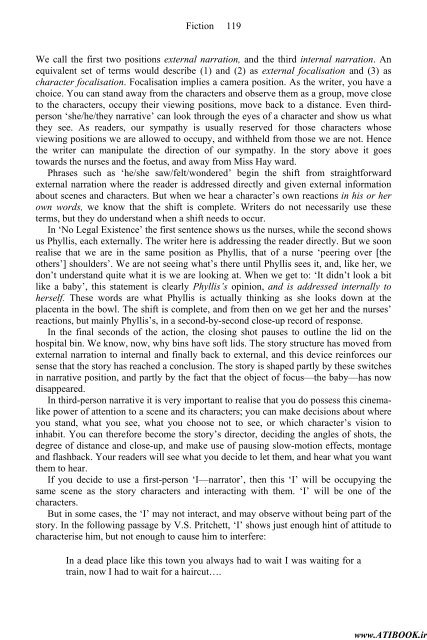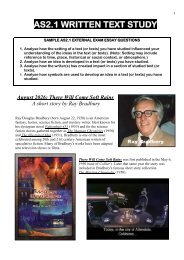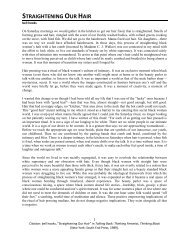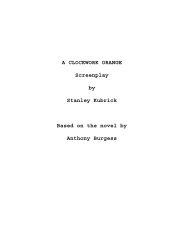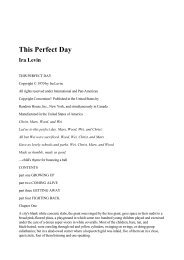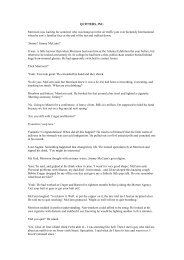9780415317856_the_routledge_creative_writing_coursebook
9780415317856_the_routledge_creative_writing_coursebook
9780415317856_the_routledge_creative_writing_coursebook
Create successful ePaper yourself
Turn your PDF publications into a flip-book with our unique Google optimized e-Paper software.
www.ATIBOOK.irFiction 119We call <strong>the</strong> first two positions external narration, and <strong>the</strong> third internal narration. Anequivalent set of terms would describe (1) and (2) as external focalisation and (3) ascharacter focalisation. Focalisation implies a camera position. As <strong>the</strong> writer, you have achoice. You can stand away from <strong>the</strong> characters and observe <strong>the</strong>m as a group, move closeto <strong>the</strong> characters, occupy <strong>the</strong>ir viewing positions, move back to a distance. Even thirdperson‘she/he/<strong>the</strong>y narrative’ can look through <strong>the</strong> eyes of a character and show us what<strong>the</strong>y see. As readers, our sympathy is usually reserved for those characters whoseviewing positions we are allowed to occupy, and withheld from those we are not. Hence<strong>the</strong> writer can manipulate <strong>the</strong> direction of our sympathy. In <strong>the</strong> story above it goestowards <strong>the</strong> nurses and <strong>the</strong> foetus, and away from Miss Hay ward.Phrases such as ‘he/she saw/felt/wondered’ begin <strong>the</strong> shift from straightforwardexternal narration where <strong>the</strong> reader is addressed directly and given external informationabout scenes and characters. But when we hear a character’s own reactions in his or herown words, we know that <strong>the</strong> shift is complete. Writers do not necessarily use <strong>the</strong>seterms, but <strong>the</strong>y do understand when a shift needs to occur.In ‘No Legal Existence’ <strong>the</strong> first sentence shows us <strong>the</strong> nurses, while <strong>the</strong> second showsus Phyllis, each externally. The writer here is addressing <strong>the</strong> reader directly. But we soonrealise that we are in <strong>the</strong> same position as Phyllis, that of a nurse ‘peering over [<strong>the</strong>o<strong>the</strong>rs’] shoulders’. We are not seeing what’s <strong>the</strong>re until Phyllis sees it, and, like her, wedon’t understand quite what it is we are looking at. When we get to: ‘It didn’t look a bitlike a baby’, this statement is clearly Phyllis’s opinion, and is addressed internally toherself. These words are what Phyllis is actually thinking as she looks down at <strong>the</strong>placenta in <strong>the</strong> bowl. The shift is complete, and from <strong>the</strong>n on we get her and <strong>the</strong> nurses’reactions, but mainly Phyllis’s, in a second-by-second close-up record of response.In <strong>the</strong> final seconds of <strong>the</strong> action, <strong>the</strong> closing shot pauses to outline <strong>the</strong> lid on <strong>the</strong>hospital bin. We know, now, why bins have soft lids. The story structure has moved fromexternal narration to internal and finally back to external, and this device reinforces oursense that <strong>the</strong> story has reached a conclusion. The story is shaped partly by <strong>the</strong>se switchesin narrative position, and partly by <strong>the</strong> fact that <strong>the</strong> object of focus—<strong>the</strong> baby—has nowdisappeared.In third-person narrative it is very important to realise that you do possess this cinemalikepower of attention to a scene and its characters; you can make decisions about whereyou stand, what you see, what you choose not to see, or which character’s vision toinhabit. You can <strong>the</strong>refore become <strong>the</strong> story’s director, deciding <strong>the</strong> angles of shots, <strong>the</strong>degree of distance and close-up, and make use of pausing slow-motion effects, montageand flashback. Your readers will see what you decide to let <strong>the</strong>m, and hear what you want<strong>the</strong>m to hear.If you decide to use a first-person ‘I—narrator’, <strong>the</strong>n this ‘I’ will be occupying <strong>the</strong>same scene as <strong>the</strong> story characters and interacting with <strong>the</strong>m. ‘I’ will be one of <strong>the</strong>characters.But in some cases, <strong>the</strong> ‘I’ may not interact, and may observe without being part of <strong>the</strong>story. In <strong>the</strong> following passage by V.S. Pritchett, ‘I’ shows just enough hint of attitude tocharacterise him, but not enough to cause him to interfere:In a dead place like this town you always had to wait I was waiting for atrain, now I had to wait for a haircut….


